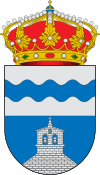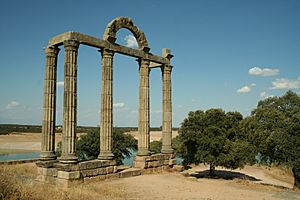Bohonal de Ibor facts for kids
Quick facts for kids
Bohonal de Ibor, Spain
|
|||
|---|---|---|---|
|
municipality
|
|||
|
|||
| Country | |||
| Autonomous community | |||
| Province | Cáceres | ||
| Municipality | Bohonal de Ibor | ||
| Area | |||
| • Total | 64 km2 (25 sq mi) | ||
| Elevation | 358 m (1,175 ft) | ||
| Population
(2018)
|
|||
| • Total | 500 | ||
| • Density | 7.8/km2 (20.2/sq mi) | ||
| Time zone | UTC+1 (CET) | ||
| • Summer (DST) | UTC+2 (CEST) | ||
Bohonal de Ibor is a small town in Spain. It is located in the province of Cáceres. This area is part of the Extremadura region.
In 2018, about 500 people lived in Bohonal de Ibor. It is known as a municipality. A municipality is like a local government area. It has its own local council and mayor.
Contents
Exploring Bohonal de Ibor
Bohonal de Ibor is a quiet place. It is surrounded by nature. The town sits at an elevation of 358 meters (about 1,175 feet). This means it is quite high up.
What is a Municipality?
A municipality is a town or city that has its own local government. This government helps manage things like local services. These services include roads, parks, and public buildings. Bohonal de Ibor is one of many municipalities in the Cáceres province.
Roman History in Bohonal de Ibor
Bohonal de Ibor has a very old history. There are remains from the Roman Empire here. One important site is called Los Mármoles. This means "The Marbles".
Los Mármoles is a set of ancient Roman columns. They were built around the 2nd century AD. These columns were part of a larger Roman building. They show that Romans lived in this area a long time ago.
The columns are a reminder of the past. They help us learn about how people lived thousands of years ago.
Geography and Location
Bohonal de Ibor is in the western part of Spain. It is part of the Extremadura region. This region is known for its beautiful landscapes. It has many natural parks and open spaces.
The province of Cáceres is quite large. Bohonal de Ibor is one of its many towns. The town covers an area of about 64 square kilometers. That's about 25 square miles.
See also
 In Spanish: Bohonal de Ibor para niños
In Spanish: Bohonal de Ibor para niños




